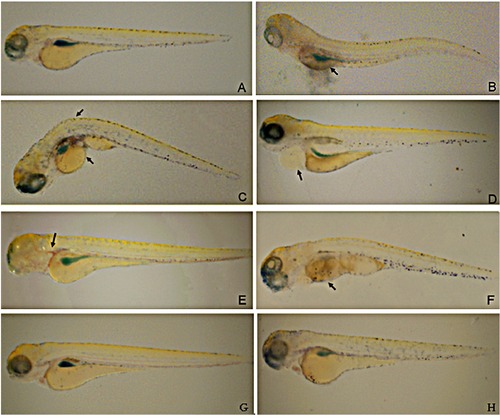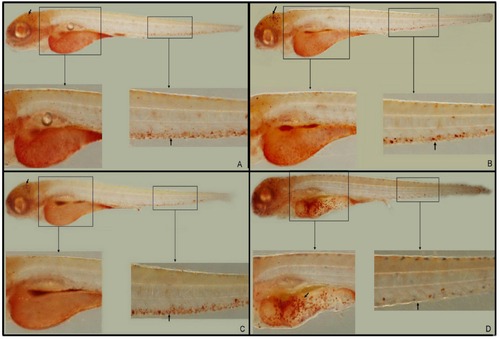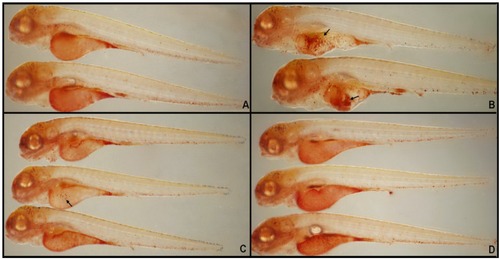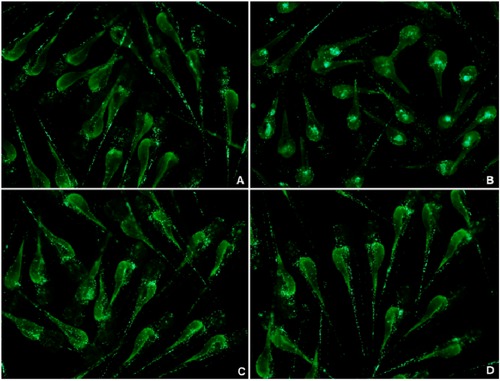- Title
-
Endotoxin molecule lipopolysaccharide-induced zebrafish inflammation model: a novel screening method for anti-inflammatory drugs
- Authors
- Yang, L.L., Wang, G.Q., Yang, L.M., Huang, Z.B., Zhang, W.Q., Yu, L.Z.
- Source
- Full text @ Molecules
|
The induction of LPS on inflammation phenotype in zebrafish. The yolks of zebrafish larvaes were injected with 0.5 mg/mL LPS to induce reproducible morphological abnormalities at 24 h. Figure B–F present the observed morphological abnormalities. (B) Necrotic yolk; (C) yolk crenulation and cyrtosis; (D) swollen pericardium sac; (E) hemorrhagic pericardium; (F) death. (A) PBS injection was used for negative control while (G) un-treated zebrafish larvaes served as normal control. Larvae exposed to 0.5 mg/mL LPS by immersion for 24 h (H). The representative images have been taken from three individual experiments (n = 34). |
|
Representative pictures of NR labeling of macrophages at 3.5 dpf. (A) Normal untreated controls; (B) zebrafish larvae immersed in LPS (0.5 mg/mL); (C) PBS-injected negative controls; and (D) larvae with LPS (0.5 mg/mL) injected into the yolk (n = 34). |
|
Representative pictures of SB labeling of neutrophils at 3 dpf. (A) Normal controls; (B) larvae immersed in LPS (0.5 mg/mL); (C) PBS-injected negative controls; and (D) larvae with LPS (0.5 mg/mL) injected into the yolk (n = 34). |
|
Representative pictures of MPO:GFP lines reveal the LPS-modeled infection process at 3 dpf. (A) Normal controls (untreated with any agents or operation); (B) larvae immersed in LPS (0.5 mg/mL); (C) PBS-injected negative controls; and (D) larvae with LPS (0.5 mg/mL) injected into the yolk (n = 34). |
|
NR labeling of macrophages at 3.5 dpf demonstrates that CA (20 mg/mL) or DEX (0.15 mg/mL, 1 nL volume per larva) significantly reduce LPS-induced macrophage recruitment. (A) PBS-injected negative controls; (B, arrow) macrophage recruitment to the yolk after LPS-injection; (C) DEX-treated, LPS-injected positive controls; and (D) CA-treated, LPS-injected larvae. |
|
SB labeling of neutrophils at 3 dpf demonstrates the anti-inflammatory effect of CA: both CA (20 mg/mL) and DEX (0.15 mg/mL) significantly reduce the neutrophil recruitment induced by LPS. (A) PBS-injected negative controls (arrowhead indicates non-specific signal); (B, arrow) neutrophil recruitment significantly increased at 6 hpi after LPS-injection; (C) DEX-treated, LPS-injected positive controls; and (D) CA-treated, LPS-injected larvae. |
|
MPO:GFP transgenic line allows tracking of neutrophils at 3.5 dpf and demonstrates the anti-inflammatory effect of CA. CA (20 mg/mL) and DEX (0.15 mg/mL) significantly reduce neutrophil recruitment and attenuate tissue necrosis induced by LPS. (A) PBS-injected negative controls; (B) neutrophil recruitment to the yolk and necrosis in LPS-injected controls; (C) DEX-treated, LPS-injected positive controls; and (D) CA-treated, LPS-injected larvae. |







